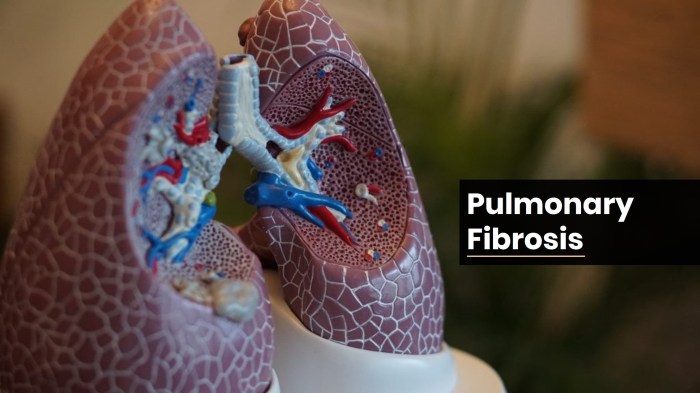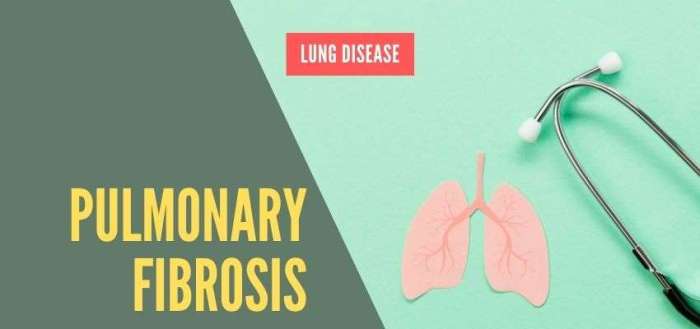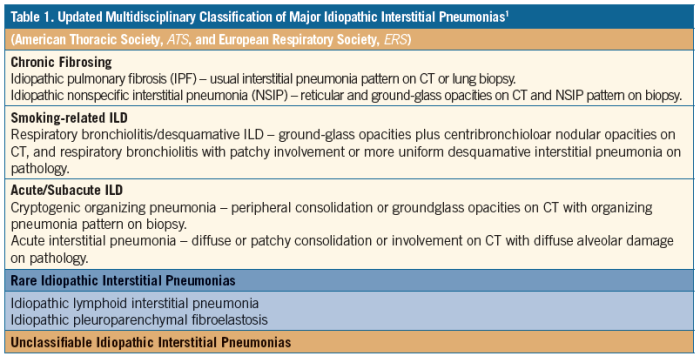Pulmonary fibrosis treatment is a crucial aspect of managing this debilitating condition, offering hope and improving the quality of life for those affected. From medications to oxygen therapy and surgical interventions, this article delves into the diverse treatment options available, empowering patients with knowledge and empowering them to make informed decisions.
Pulmonary fibrosis is a progressive lung disease characterized by scarring and thickening of lung tissue, making breathing increasingly difficult. Understanding the different types, causes, and symptoms of pulmonary fibrosis is essential for timely diagnosis and effective treatment.
Overview of Pulmonary Fibrosis

Pulmonary fibrosis is a chronic lung disease characterized by the scarring and thickening of lung tissue. This scarring makes it difficult for oxygen to pass from the lungs into the bloodstream, leading to shortness of breath and other respiratory problems.
There are many different types of pulmonary fibrosis, each with its own unique cause and treatment. Some of the most common types include idiopathic pulmonary fibrosis (IPF), which is a type of pulmonary fibrosis with no known cause, and asbestosis, which is caused by exposure to asbestos.
Pulmonary fibrosis is a serious disease that can lead to disability and even death. However, there are treatments available that can help to slow the progression of the disease and improve quality of life.
Causes and Risk Factors
The exact cause of pulmonary fibrosis is unknown, but there are a number of risk factors that have been identified, including:
- Smoking
- Exposure to asbestos
- Exposure to other occupational toxins, such as silica and coal dust
- Certain autoimmune diseases, such as rheumatoid arthritis and lupus
- Certain medications, such as methotrexate and amiodarone
- Radiation therapy to the chest
- Certain genetic mutations
People who have one or more of these risk factors are more likely to develop pulmonary fibrosis, but it is important to note that not everyone who has these risk factors will develop the disease.
Symptoms and Diagnosis of Pulmonary Fibrosis
Pulmonary fibrosis, a chronic and progressive lung disease, often presents with a range of symptoms that may vary in severity. Early detection and accurate diagnosis are crucial for timely management and improving outcomes.
Symptoms
Common symptoms of pulmonary fibrosis include:
- Progressive shortness of breath, especially with exertion
- Dry, hacking cough
- Fatigue and weakness
- Weight loss and decreased appetite
- Aching muscles and joints
- Fingertips or toenails that are enlarged or rounded (clubbing)
Diagnosis
Confirming a diagnosis of pulmonary fibrosis involves a comprehensive evaluation, including:
Medical History and Physical Examination
A thorough medical history and physical examination can provide valuable clues about the patient’s symptoms, risk factors, and overall health.
Imaging Techniques
Imaging tests play a crucial role in diagnosing pulmonary fibrosis:
- Chest X-ray:May reveal characteristic changes in lung tissue, such as interstitial thickening and scarring.
- High-resolution computed tomography (HRCT):Provides detailed images of the lungs, allowing for more precise evaluation of lung tissue abnormalities.
- Magnetic resonance imaging (MRI):Can detect inflammation and fibrosis in the lungs.
Lung Function Tests
These tests measure the amount of air that can be inhaled and exhaled, as well as the efficiency of gas exchange in the lungs.
Biopsy, Pulmonary fibrosis treatment
In some cases, a lung biopsy may be necessary to confirm the diagnosis. This involves removing a small sample of lung tissue for examination under a microscope.
Treatment Options for Pulmonary Fibrosis

Pulmonary fibrosis is a progressive lung disease with no cure. However, there are treatments that can help slow the progression of the disease and improve symptoms. The goals of treatment for pulmonary fibrosis are to reduce inflammation and scarring in the lungs, improve lung function, and relieve symptoms.
There are a variety of medications that can be used to treat pulmonary fibrosis. These medications include:
- Anti-inflammatory drugs:These drugs help to reduce inflammation in the lungs. Examples of anti-inflammatory drugs used to treat pulmonary fibrosis include prednisone and azathioprine.
- Anti-fibrotic drugs:These drugs help to slow the progression of scarring in the lungs. Examples of anti-fibrotic drugs used to treat pulmonary fibrosis include pirfenidone and nintedanib.
- Immunosuppressants:These drugs help to suppress the immune system, which can help to reduce inflammation and scarring in the lungs. Examples of immunosuppressants used to treat pulmonary fibrosis include cyclosporine and tacrolimus.
Oxygen therapy may also be used to treat pulmonary fibrosis. Oxygen therapy involves breathing in supplemental oxygen to help improve blood oxygen levels. Oxygen therapy can be used at home or in the hospital.
In some cases, surgery may be an option for treating pulmonary fibrosis. Surgery may be used to remove damaged lung tissue or to transplant a new lung.
Management of Pulmonary Fibrosis
Pulmonary fibrosis is a progressive lung disease that can lead to shortness of breath, coughing, and fatigue. While there is no cure for pulmonary fibrosis, there are treatments that can help to manage the symptoms and improve quality of life.
Lifestyle Modifications
Lifestyle modifications can play an important role in managing pulmonary fibrosis. These modifications include:
- Quitting smoking
- Avoiding secondhand smoke
- Getting regular exercise
- Eating a healthy diet
- Getting enough sleep
Pulmonary Rehabilitation
Pulmonary rehabilitation is a program of exercise, education, and support that can help people with pulmonary fibrosis to improve their quality of life. Pulmonary rehabilitation programs typically include:
- Supervised exercise
- Education about pulmonary fibrosis
- Support groups
Managing Breathlessness
Breathlessness is a common symptom of pulmonary fibrosis. There are a number of things that people with pulmonary fibrosis can do to manage breathlessness, including:
- Using a bronchodilator
- Using oxygen therapy
- Pacing activities
- Learning breathing techniques
Prognosis and Outlook for Pulmonary Fibrosis: Pulmonary Fibrosis Treatment

Pulmonary fibrosis is a progressive disease, meaning it tends to worsen over time. The prognosis for people with pulmonary fibrosis varies depending on the type and severity of the disease, as well as the individual’s overall health and response to treatment.Factors that can affect the prognosis of pulmonary fibrosis include:
- Type of pulmonary fibrosis: Some types of pulmonary fibrosis are more aggressive than others.
- Severity of the disease: The extent and severity of the scarring in the lungs can affect the prognosis.
- Age: Older people with pulmonary fibrosis tend to have a worse prognosis than younger people.
- Overall health: People with other health conditions, such as heart disease or lung disease, may have a worse prognosis.
- Response to treatment: Some people respond well to treatment, while others do not.
Life Expectancy and Survival Rates
The life expectancy and survival rates for people with pulmonary fibrosis vary depending on the factors mentioned above. In general, the average life expectancy for people with pulmonary fibrosis is 3-5 years after diagnosis. However, some people may live for many years with the disease, while others may die within a few months.
Support Groups and Resources
There are a number of support groups and resources available for people with pulmonary fibrosis. These groups can provide emotional support, information about the disease, and resources to help people cope with the challenges of living with pulmonary fibrosis.Some of the most well-known support groups for people with pulmonary fibrosis include:
- The Pulmonary Fibrosis Foundation
- The American Lung Association
- The National Organization for Rare Disorders
These groups offer a variety of services, including:
- Support groups
- Educational materials
- Advocacy
- Research funding
Ultimate Conclusion
Managing pulmonary fibrosis involves a multifaceted approach that encompasses lifestyle modifications, pulmonary rehabilitation, and symptom management. By adopting healthy habits, engaging in tailored exercise programs, and seeking support from healthcare professionals and support groups, individuals with pulmonary fibrosis can optimize their well-being and live fulfilling lives.
While the prognosis of pulmonary fibrosis varies, ongoing research and advancements in treatment offer hope for improved outcomes. Patients can find solace and guidance through support groups and resources dedicated to providing emotional and practical assistance.
FAQ Resource
What are the common symptoms of pulmonary fibrosis?
Shortness of breath, dry cough, fatigue, and crackling sounds in the lungs are common symptoms.
How is pulmonary fibrosis diagnosed?
Diagnosis involves a combination of physical examination, imaging tests (such as X-rays and CT scans), and lung function tests.
What are the treatment goals for pulmonary fibrosis?
Treatment aims to slow the progression of the disease, relieve symptoms, improve quality of life, and extend life expectancy.
What are the surgical options for pulmonary fibrosis?
Lung transplantation is a potential surgical option for severe cases, but it carries significant risks and is not suitable for all patients.